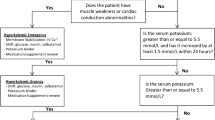Abstract
Background Hyperkalemia is a potentially dangerous electrolyte abnormality with a reported incidence of 1–10 % in hospitals. Patients are especially at risk of developing this complication if they use a combination of potassium supplements and potassium sparing diuretics or renin–angiotensin–aldosterone-system (RAAS) inhibitors. Previous studies on the occurrence of hyperkalemia in patients who use multiple potassium influencing drugs simultaneously were either small in sample size or did not investigate the full range of drugs involved. Objective To assess the prevalence of hyperkalemia and to identify risk factors for its development in hospitalised patients using potassium supplements, potassium-sparing diuretics and/or RAAS-inhibitors concurrently. Setting The study was conducted at the Onze Lieve Vrouwe Hospital in Amsterdam, The Netherlands from January 2009 to May 2010. Method A retrospective, nested case–control study included hospitalised patients who used a combination of potassium-influencing drugs. Cases were patients with serum potassium ≥5.5 mmol/l, controls were patients with normal serum potassium levels. Cases and controls were included in a ratio of 1:2. The following known risk factors associated with hyperkalemia were recorded and statistically analyzed: diabetes mellitus, congestive heart failure, decreased renal function, advanced age, gender and use of heparin, digoxin, non-steroidal anti-inflammatory drugs, beta-blockers, calcineurin antagonists and trimethoprim. Main outcome measure Identify risk factors for the development of hyperkalemia as a result of the concurrent use of potassium supplements, RAAS inhibitors and/or potassium-sparing diuretics. Results Of 774 patients included in this study, 52 patients developed hyperkalemia; a prevalence of 6.7 %. The only risk factor found to be significantly associated with hyperkalemia was lowered renal function, expressed as estimated glomerular filtration rate (eGFR) <50 ml/min (adjusted OR 5.08; 95 % CI 2.46–10.48). None of the other tested risk factors was identified as significant. Conclusion This study showed that decreased renal function (eGFR <50 ml/min) was associated with a fivefold increased risk for hyperkalemia in patients using potassium-influencing drugs. While previous studies showed that hyperkalemia substantially increases below a threshold of eGFR <30 or 40 ml/min, we observed a lower threshold of eGFR <50 ml/min. It is therefore recommended that physicians should be particularly alert while monitoring the use of potassium-influencing drugs in patients with decreased renal function.
Similar content being viewed by others
References
Schaefer TJ, Wolford RW. Disorders of potassium. Emerg Med Clin N Am. 2005;23(3):723–47.
Paice B, Gray JMB, McBride D, Donnelly T, Lawson DH. Hyperkalemia in patients in hospital. BMJ. 1983;286:1189–92.
Acker GC, Johnson JJ, Palevsky PM, Greenberg A. Hyperkalemia in hospitalized patients: causes, adequacy of treatment, and results of an attempt to improve physician compliance with published therapy guidelines. Arch Intern Med. 1998;158(8):917–24.
Rimmer JM, Horn JF, Gennari FJ. Hyperkalemia as a complication of drug therapy. Arch Intern Med. 1987;147:867–9.
National Cancer Institute, U.S. department of health and human services. Common Terminology Criteria for Adverse Events (CTCAE) Version 4.03. 2010.
Palmer BF. Managing hyperkalemia caused by inhibitors of the renin–angiotensin–aldosterone system. N Engl J Med. 2004;351:585–92.
Takaichi K, Takemoto F, Yoshifumi U, Mori Y. Analysis of factors causing hyperkalemia. Intern Med. 2007;46:823–9.
Juurlink DN, Mamdani MM, Lee DS, Kopp A, Austin PC, Laupacis A, et al. Rates of hyperkalemia after publication of the randomized aldactone evaluation study. N Engl J Med. 2004;351:543–51.
Schepkens H, Vanholder R, Billiouw JM, Lameire N. Life-threatening hyperkalemia during combined therapy with angiotensin-converting enzyme inhibitors and spironolactone: an analysis of 25 cases. Am J Med. 2001;110:438–41.
Khanna A, White WB. The management of hyperkalemia in patients with cardiovascular disease. Am J Med. 2009;122:215–21.
Ramadan FH, Masoodi N, El-Solh AA. Clinical factors associated with hyperkalemia in patients with congestive heart failure. J Clin Pharm Ther. 2005;30:233–9.
Amir O, Hassan Y, Sarriff A, Awaisu A, Aziz NA, Ismail O. Incidence of risk factors for developing hyperkalemia when using ACE inhibitors in cardiovascular diseases. Pharm World Sci. 2009;31:287–93.
Biesheuvel CJ, Vergouwe Y, Oudega R, Hoes AH, Grobbee DE, Moons KGM. Advantages of the nested case control design in diagnostic research. BMC Med Res Methodol. 2008;8:48.
Klahr S, Levey AS, Beck GJ, Caggiula AW, Hunsicker L, Kusek JW, et al. The effects of dietary protein restriction and blood-pressure control on the progression of chronic renal disease. Modification of diet in Renal Disease Study Group. N Engl J Med. 1994;330(13):929–30.
Acknowledgments
None.
Funding
None.
Conflicts of interest
None to declare.
Author information
Authors and Affiliations
Corresponding author
Rights and permissions
About this article
Cite this article
Kuijvenhoven, M.A., Haak, E.A.F., Gombert-Handoko, K.B. et al. Evaluation of the concurrent use of potassium-influencing drugs as risk factors for the development of hyperkalemia. Int J Clin Pharm 35, 1099–1104 (2013). https://doi.org/10.1007/s11096-013-9830-8
Received:
Accepted:
Published:
Issue Date:
DOI: https://doi.org/10.1007/s11096-013-9830-8




